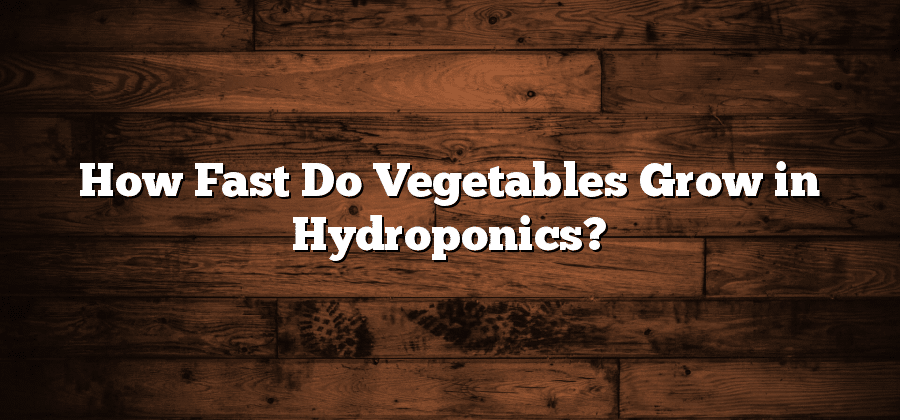Factors Affecting Vegetable Growth in Hydroponics
Hydroponics, as a method of growing plants without soil, has gained increasing popularity in recent years. The success of vegetable growth in hydroponics depends on a number of factors that must be carefully monitored and controlled. One significant factor is the quality of the nutrient solution used in the hydroponic system. This solution serves as the primary source of essential minerals and nutrients for the plants. Vital macronutrients such as nitrogen (N), phosphorus (P), and potassium (K) must be present in balanced quantities to promote optimal growth. Additionally, micronutrients like iron (Fe), calcium (Ca), and magnesium (Mg) are necessary for various biochemical reactions within the plants’ systems. By maintaining the right nutrient solution composition, hydroponic growers can ensure healthy and robust growth of their vegetables.
Light intensity is another crucial factor that affects vegetable growth in hydroponics. As plants utilize light energy for photosynthesis, the availability and intensity of light can significantly impact their overall growth and development. Vegetables grown in hydroponics systems require an appropriate amount of light to maximize photosynthetic activity. Insufficient light can lead to reduced photosynthesis, resulting in stunted growth and weak plants. Conversely, excessive light intensity can cause stress and damage to the plants. Balancing the light intensity is crucial, and this can be achieved by selecting suitable artificial lighting sources such as LED or fluorescent lights, or by ensuring an optimal light-to-plant distance in natural light setups. When light intensity is carefully regulated, hydroponic growers can cultivate strong and healthy vegetables with optimal growth rates.
Understanding the Growth Cycle of Hydroponic Vegetables
The growth cycle of hydroponic vegetables is a process that involves several stages, each crucial for the successful development of the plants. The first stage is germination, where the seeds begin to sprout and form roots. During this stage, it is essential to ensure that the seeds receive proper moisture and temperature conditions in order to promote healthy growth. Once the seeds have germinated, they enter the vegetative stage, where the focus is on leaf and stem development. This stage is characterized by rapid growth, and it is crucial to provide the plants with the appropriate **nutrient solution** to support their nutritional needs.
After the vegetative stage, the plants enter the flowering stage, where they start to produce flowers or fruit, depending on the type of vegetable. At this stage, it is important to provide the plants with the right balance of **nutrients**, as well as **light intensity** to support the development of healthy flowers or fruits. Finally, the plants reach the last stage of their growth cycle, which is the ripening stage. In this stage, the vegetables reach their full maturity and are ready for harvest. It is essential to monitor the plants closely during this stage and harvest them at the optimal time to ensure the best flavor and quality. Understanding the growth cycle of hydroponic vegetables is crucial for successful cultivation and can help growers make informed decisions throughout the entire process.
Nutrient Solutions: A Key Component in Vegetable Growth
With the rise in popularity of hydroponics, understanding the role of nutrient solutions in vegetable growth is crucial for successful cultivation. Nutrient solutions serve as the primary source of essential elements for plants in hydroponic systems. These solutions are carefully formulated to provide a balanced mixture of nutrients that are vital for plant growth and development. By delivering the necessary macronutrients, such as nitrogen (N), phosphorus (P), and potassium (K), as well as micronutrients like iron (Fe) and zinc (Zn), nutrient solutions ensure that plants receive all the necessary building blocks for healthy growth.
An effective nutrient solution not only provides the essential elements, but it also ensures their availability and balance for optimal uptake by the plants. This is accomplished by adjusting the pH level and monitoring the electrical conductivity (EC) of the solution. Maintaining the correct pH range, usually between 5.5 and 6.5, enables plants to efficiently absorb nutrients. Additionally, the EC level indicates the overall concentration of nutrients in the solution, helping growers maintain the desired strength of the nutrient solution. This careful management of pH and EC levels ensures that plants have a constant supply of nutrients throughout their growth cycle, promoting vigorous growth and higher crop yields.
The Impact of Light Intensity on Vegetable Growth in Hydroponics
Light intensity plays a crucial role in the growth of vegetables in hydroponics. As photosynthesis is the process through which plants convert light energy into chemical energy, the intensity of light directly affects their ability to produce food. Insufficient light intensity can lead to slower growth, smaller plant size, and reduced yield. On the other hand, excessive light intensity can cause stress and damage to the plants. Therefore, finding the right balance of light intensity is essential for optimal vegetable growth in hydroponics.
Several factors determine the ideal light intensity for different vegetables in hydroponics. The type of vegetable, its growth stage, and the specific requirements of the plant should all be considered. Leafy greens, such as lettuce and spinach, generally thrive in lower light intensity compared to fruiting vegetables like tomatoes and peppers. Additionally, the growth stage of the plants is crucial in determining the appropriate light intensity. Seedlings and young plants require lower light intensity compared to mature plants. By adjusting the light intensity based on these considerations, hydroponic growers can maximize the growth and productivity of their vegetable crops. However, it is essential to note that light intensity is just one aspect of light management in hydroponics, and other factors, such as light duration and light spectrum, also play significant roles in vegetable growth.






